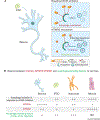Autophagy: Identification of MTMR5 as a neuron-enriched suppressor
- PMID: 35728530
- PMCID: PMC9994184
- DOI: 10.1016/j.cub.2022.04.075
Autophagy: Identification of MTMR5 as a neuron-enriched suppressor
Abstract
A puzzle of autophagy in neurons is that, unlike in other cells, it is not robustly induced by inhibition of mammalian target of rapamycin (mTOR). A new study now solves this conundrum and establishes that myotubularin-related phosphatase 5 limits the induction of neuronal autophagy by mTOR inhibitors.
Copyright © 2022 Elsevier Inc. All rights reserved.
Conflict of interest statement
Declaration of interests The authors declare no competing interests.
Figures

Comment on
-
Myotubularin-related phosphatase 5 is a critical determinant of autophagy in neurons.Curr Biol. 2022 Jun 20;32(12):2581-2595.e6. doi: 10.1016/j.cub.2022.04.053. Epub 2022 May 16. Curr Biol. 2022. PMID: 35580604 Free PMC article.
References
-
- Nakatogawa H (2020). Mechanisms governing autophagosome biogenesis. Nat. Rev. Mol. Cell Biol. 21, 439–458. - PubMed
Publication types
MeSH terms
Substances
Grants and funding
LinkOut - more resources
Full Text Sources
Miscellaneous

